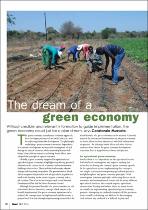JavaScript is disabled for your browser. Some features of this site may not work without it.
- ResearchSpace
- →
- Research Publications/Outputs
- →
- Journal Articles
- →
- View Item
| dc.contributor.author |
Musvoto, Constansia D

|
|
| dc.date.accessioned | 2016-10-13T13:03:56Z | |
| dc.date.available | 2016-10-13T13:03:56Z | |
| dc.date.issued | 2015-12 | |
| dc.identifier.citation | Musvoto, C.D. 2015. The dream of a green economy: cover story. Quest, vol 12(1), p.p. 18-19 | en_US |
| dc.identifier.issn | 1729-830X | |
| dc.identifier.uri | http://hdl.handle.net/10204/8815 | |
| dc.description | Copyright: 2015 SA ePublications | en_US |
| dc.description.abstract | The green economy, with its underlying philosophy of reducing the dependence of economic development on the increased consumption of and damage to natural resources is a tool for achieving sustainable development. Globally, a green economy supported by agriculture (an agricultural green economy) is particularly highlighted as offering potential solutions to current social, economic and environmental challenges which humanity faces. These challenges include food insecurity, climate change and increasing inequalities. The government of South Africa recognises the potential role of agriculture, in particular small scale farming in the country's green economy and in job creation. At present, most of the documented information on the green economy is theoretical in nature, with little information on green economy practice. Research conducted by the Natural Resources and the environment unit of CSIR identified the availability of relevant and credible project level information as being critical for green economy implementation, with two categories of information being vital: (i) contextual information that builds an understanding of the green economy and thus flexibility in its implementation; and (ii) operational information. Green economy implementation guidelines should provide this type of information. For South Africa to move beyong intent and make the green economy a reality, investments are needed. However, before investing in necessities such as infrastructure and equipment, it is necessary to build capacity to implement projects. Provision of relevant guideline information to those involved in implementation (both directly and indirectly) is a key part of capacity building. | en_US |
| dc.language.iso | en | en_US |
| dc.publisher | SA ePublications | en_US |
| dc.relation.ispartofseries | Workflow;16490 | |
| dc.subject | Green economy | en_US |
| dc.subject | Guideline | en_US |
| dc.subject | Implementation | en_US |
| dc.title | The dream of a green economy: cover story | en_US |
| dc.type | Article | en_US |
| dc.identifier.apacitation | Musvoto, C. D. (2015). The dream of a green economy: cover story. http://hdl.handle.net/10204/8815 | en_ZA |
| dc.identifier.chicagocitation | Musvoto, Constansia D "The dream of a green economy: cover story." (2015) http://hdl.handle.net/10204/8815 | en_ZA |
| dc.identifier.vancouvercitation | Musvoto CD. The dream of a green economy: cover story. 2015; http://hdl.handle.net/10204/8815. | en_ZA |
| dc.identifier.ris | TY - Article AU - Musvoto, Constansia D AB - The green economy, with its underlying philosophy of reducing the dependence of economic development on the increased consumption of and damage to natural resources is a tool for achieving sustainable development. Globally, a green economy supported by agriculture (an agricultural green economy) is particularly highlighted as offering potential solutions to current social, economic and environmental challenges which humanity faces. These challenges include food insecurity, climate change and increasing inequalities. The government of South Africa recognises the potential role of agriculture, in particular small scale farming in the country's green economy and in job creation. At present, most of the documented information on the green economy is theoretical in nature, with little information on green economy practice. Research conducted by the Natural Resources and the environment unit of CSIR identified the availability of relevant and credible project level information as being critical for green economy implementation, with two categories of information being vital: (i) contextual information that builds an understanding of the green economy and thus flexibility in its implementation; and (ii) operational information. Green economy implementation guidelines should provide this type of information. For South Africa to move beyong intent and make the green economy a reality, investments are needed. However, before investing in necessities such as infrastructure and equipment, it is necessary to build capacity to implement projects. Provision of relevant guideline information to those involved in implementation (both directly and indirectly) is a key part of capacity building. DA - 2015-12 DB - ResearchSpace DP - CSIR KW - Green economy KW - Guideline KW - Implementation LK - https://researchspace.csir.co.za PY - 2015 SM - 1729-830X T1 - The dream of a green economy: cover story TI - The dream of a green economy: cover story UR - http://hdl.handle.net/10204/8815 ER - | en_ZA |






